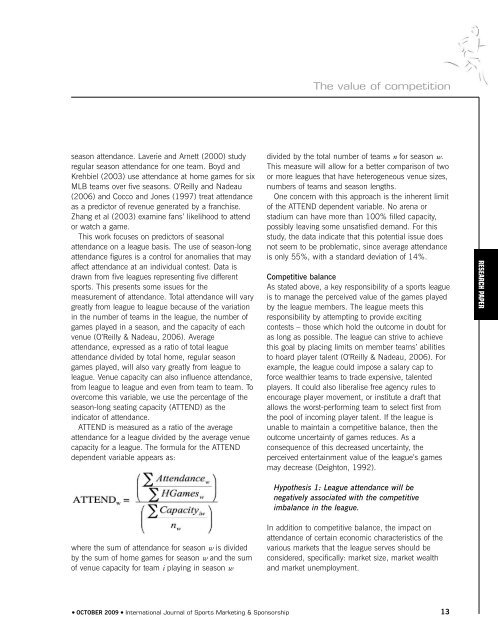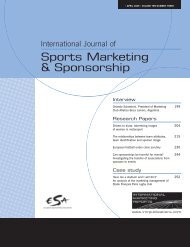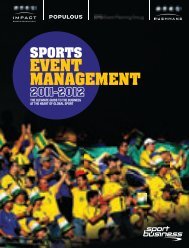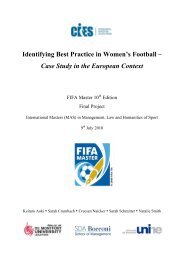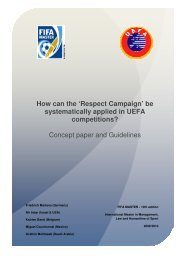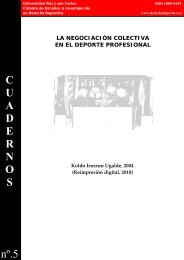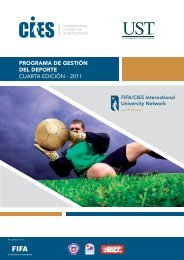Sports Marketing & Sponsorship - FIFA/CIES International University ...
Sports Marketing & Sponsorship - FIFA/CIES International University ...
Sports Marketing & Sponsorship - FIFA/CIES International University ...
- No tags were found...
Create successful ePaper yourself
Turn your PDF publications into a flip-book with our unique Google optimized e-Paper software.
The value of competitionseason attendance. Laverie and Arnett (2000) studyregular season attendance for one team. Boyd andKrehbiel (2003) use attendance at home games for sixMLB teams over five seasons. O’Reilly and Nadeau(2006) and Cocco and Jones (1997) treat attendanceas a predictor of revenue generated by a franchise.Zhang et al (2003) examine fans’ likelihood to attendor watch a game.This work focuses on predictors of seasonalattendance on a league basis. The use of season-longattendance figures is a control for anomalies that mayaffect attendance at an individual contest. Data isdrawn from five leagues representing five differentsports. This presents some issues for themeasurement of attendance. Total attendance will varygreatly from league to league because of the variationin the number of teams in the league, the number ofgames played in a season, and the capacity of eachvenue (O’Reilly & Nadeau, 2006). Averageattendance, expressed as a ratio of total leagueattendance divided by total home, regular seasongames played, will also vary greatly from league toleague. Venue capacity can also influence attendance,from league to league and even from team to team. Toovercome this variable, we use the percentage of theseason-long seating capacity (ATTEND) as theindicator of attendance.ATTEND is measured as a ratio of the averageattendance for a league divided by the average venuecapacity for a league. The formula for the ATTENDdependent variable appears as:where the sum of attendance for season w is dividedby the sum of home games for season w and the sumof venue capacity for team i playing in season wdivided by the total number of teams n for season w.This measure will allow for a better comparison of twoor more leagues that have heterogeneous venue sizes,numbers of teams and season lengths.One concern with this approach is the inherent limitof the ATTEND dependent variable. No arena orstadium can have more than 100% filled capacity,possibly leaving some unsatisfied demand. For thisstudy, the data indicate that this potential issue doesnot seem to be problematic, since average attendanceis only 55%, with a standard deviation of 14%.Competitive balanceAs stated above, a key responsibility of a sports leagueis to manage the perceived value of the games playedby the league members. The league meets thisresponsibility by attempting to provide excitingcontests – those which hold the outcome in doubt foras long as possible. The league can strive to achievethis goal by placing limits on member teams’ abilitiesto hoard player talent (O’Reilly & Nadeau, 2006). Forexample, the league could impose a salary cap toforce wealthier teams to trade expensive, talentedplayers. It could also liberalise free agency rules toencourage player movement, or institute a draft thatallows the worst-performing team to select first fromthe pool of incoming player talent. If the league isunable to maintain a competitive balance, then theoutcome uncertainty of games reduces. As aconsequence of this decreased uncertainty, theperceived entertainment value of the league’s gamesmay decrease (Deighton, 1992).Hypothesis 1: League attendance will benegatively associated with the competitiveimbalance in the league.In addition to competitive balance, the impact onattendance of certain economic characteristics of thevarious markets that the league serves should beconsidered, specifically: market size, market wealthand market unemployment.RESEARCH PAPER● OCTOBER 2009 ● <strong>International</strong> Journal of <strong>Sports</strong> <strong>Marketing</strong> & <strong>Sponsorship</strong>13


